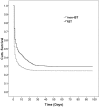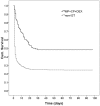Addition of immunosuppressive treatment to hemoperfusion is associated with improved survival after paraquat poisoning: a nationwide study
- PMID: 24475310
- PMCID: PMC3903773
- DOI: 10.1371/journal.pone.0087568
Addition of immunosuppressive treatment to hemoperfusion is associated with improved survival after paraquat poisoning: a nationwide study
Abstract
Paraquat poisoning associates very high mortality rate. Early treatment with hemoperfusion is strongly suggested by animal and human studies. Although the survival benefit of additional immunosuppressive treatment (IST) in combination with hemoperfusion is also reported since 1971, the large-scale randomized control trials to confirm the effects of IST is difficult to be executed. Therefore, we designed this nationwide large-scale population-based retrospective cohort study to investigate the outcome of paraquat poisoning with hemoperfusion and the additional effects of IST combined with hemoperfusion. This nationwide retrospective cohort study utilized data retrieved from the National Health Insurance Research Database (NHIRD) of Taiwan. A total of 1811 hospitalized patients with a diagnosis of paraquat poisoning who received hemoperfusion between 1997 and 2009 were enrolled. The mean age of all 1811 study subjects was 47.3 years. 70% was male. The overall survival rate was only 26.4%. Respiratory failure and renal failure were diagnosed in 56.2% and 36% patients. The average frequency of hemoperfusion was twice. IST was added in 42.2% patients. IST significantly increases survival rate (from 24.3% to 29.3%, P<0.001). The combined IST with methylprednisolone, cyclophosphamide and dexamethasone associates with the highest survival rate (48%, P<0.001). Moreover, patients younger than 45 years of age in the IST group had the best survival (41.0% vs. 33.7%, p<0.001). Our results support the use of IST with hemoperfusion for paraquat-poisoned patients. The best survival effect of IST is the combination of methylprednisolone, cyclophosphamide and daily dexamethasone, especially in patients with younger age.
Conflict of interest statement
Figures





References
-
- Dinis-Oliveira RJ, Duarte JA, Sanchez-Navarro A, Remiao F, Bastos ML, et al. (2008) Paraquat poisonings: mechanisms of lung toxicity, clinical features, and treatment. Crit Rev Toxicol 38: 13–71. - PubMed
-
- Meredith TJ, Vale JA (1987) Treatment of paraquat poisoning in man: methods to prevent absorption. Hum Toxicol 6: 49–55. - PubMed
-
- Bismuth C, Scherrmann JM, Garnier R, Baud FJ, Pontal PG (1987) Elimination of paraquat. Hum Toxicol 6: 63–67. - PubMed
-
- Bateman DN (1987) Pharmacological treatments of paraquat poisoning. Hum Toxicol 6: 57–62. - PubMed
MeSH terms
Substances
LinkOut - more resources
Full Text Sources
Other Literature Sources
Medical

